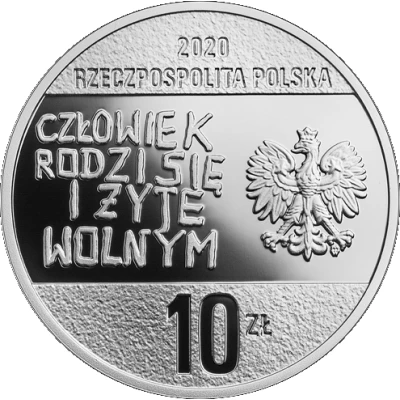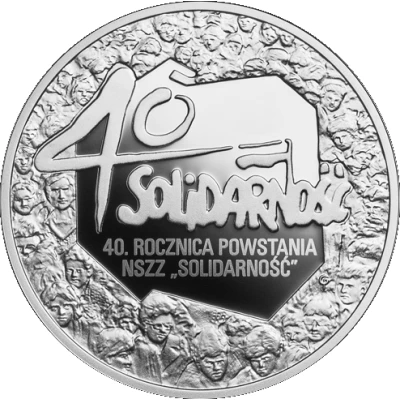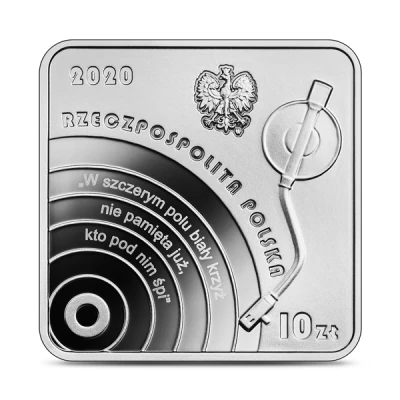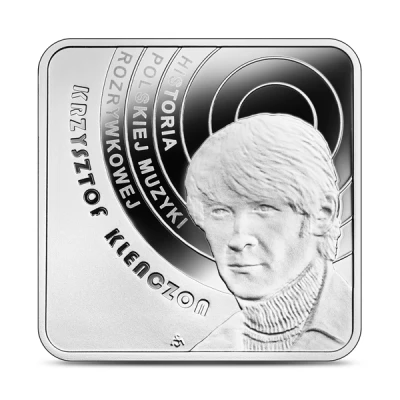
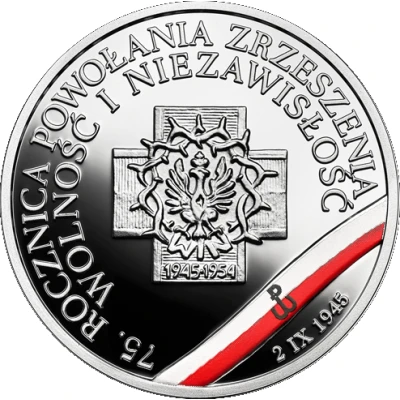

10 Zlotys "Freedom and Independence" Association
2020 year| Silver (.925) (pad printing) | 14.14 g | 32 mm |
| Issuer | Poland |
|---|---|
| Period | Third Republic (1989-date) |
| Type | Non-circulating coin |
| Year | 2020 |
| Value | 10 Zlotys (10 Złotych) 10 PLN = USD 2.54 |
| Currency | Fourth Zloty (1995-date) |
| Composition | Silver (.925) (pad printing) |
| Weight | 14.14 g |
| Diameter | 32 mm |
| Shape | Round |
| Technique | Milled |
| Orientation | Medal alignment ↑↑ |
| Updated | 2024-10-07 |
| Numista | N#231845 |
|---|---|
| Rarity index | 93% |
Reverse
Script: Latin
Lettering:
75. ROCZNICA POWOŁANIA ZRZESZENIA
WOLNOŚĆ I NIEZAWISŁOŚĆ
2 IX 1945
Designer: Dobrochna Surajewska
Edge
Plain
Comment
The “Freedom and Independence” Association (full name: the Resistance Movement without War and Sabotage “Freedom and Independence”), better known for its Polish acronym WiN, was a successor of the Polish
Home Army in its ideas and activity. WiN was mostly made up of Home Army soldiers and it also took over its organisational structures. As opposed to the Home Army, it was civilian in principle, yet there were also
numerous military units among its ranks, particularly in the Białystok, Lublin and Warsaw districts. Hence WiN
was an organisation that was both military and political. That is why the successive four commandants of WiN
(who would also identify themselves as “presidents” to emphasise their civilian role) – Col. Jan Rzepecki, Col.
Franciszek Niepokólczycki, Lt. Col. Wincenty Kwieciński and Lt. Col. Łukasz Ciepliński – should also be referred
to as Home Army commandants. The biggest underground army in the German-occupied Europe – the Home Army (AK) – was disbanded on 19 January 1945 by General Leopold Okulicki. Nonetheless, as the country was threatened by Soviet oppression, the guiding idea of AK was reborn on 7 May 1945 in the form of the Armed Forces Delegation for Poland, which in turn established the “Freedom and Independence” Association on 2 September 1945. Initially, WiN’s goal was to prevent the electoral victory of communists in Poland by political means, keeping the free world informed of their crimes, lies, frauds and deception; however, the mounting Soviet terror forced the organisation to continue its armed struggle as well. Guerrilla units defended civilians against the occupier, forcibly entered into prisons freeing the prisoners, attacked the headquarters of the Department of Security and the Citizens’ Militia, fought with the Internal Security Corps and liquidated the functionaries and agents of the Communist regime. In 1946, the organisation placed itself under the authority
of the Polish government-in-exile and the Commander-in-Chief of the Polish Armed Forces in the West. WiN did not recognize the Polish borders established in Yalta, it demanded that the Red Army and NKVD leave Poland, and protested against political prosecution and the destruction and pillage of the national property. It looked to the Western states for aid, hoping for the outbreak of World War III in particular. Its social agenda included the socialisation of enterprises, universal education and agricultural reform. The association was being broken up by Soviet and Communist agencies. Its members either died in combat or were arrested, subjected to brutal investigations and very often murdered under unlawful court sentences. From spring 1948, the association was under the control of the so-called 5th WiN Headquarters, which proved to be a set-up by the Department of Security, as a consequence of which by December 1952 the organisation had been totally
infiltrated and compromised (including the foreign delegacy), deprived of its means of operation and
broken up. On 1 March 1951, at the Communist prison at Rakowiecka Street in Warsaw, seven commanding officers of the last pro-independence 4th Headquarters (Chief Command) of WiN, with Lt. Col. Łukasz Ciepliński at the helm, were murdered with a shot in the back of the head. In 2011, to commemorate the heroic attitude of the pro-independence and anti-communist underground movement, the 1st of March was established as an
official national holiday in Poland – the Enduring Soldiers’ National Remembrance Day. Source : NBP.PL
Date of issue 27-08-2020
Interesting fact
The obverse of the coin features an image of a stork, which is a symbol of freedom and independence in Polish culture. The stork is depicted carrying a baby in its beak, which represents the hope for a bright and prosperous future for the nation. The coin's design is meant to commemorate the 100th anniversary of Poland's independence and to honor the sacrifices made by the country's citizens in the fight for freedom.
Price
| Date | Mintage | VG | F | VF | XF | AU | UNC |
|---|---|---|---|---|---|---|---|
| 2020 MW | 11000 | - | - | - | - | - | - |
Values in the table are based on evaluations by sales realized on Internet platforms. They serve as an indication only for 10 Zlotys ("Freedom and Independence" Association) 2020 coin.
